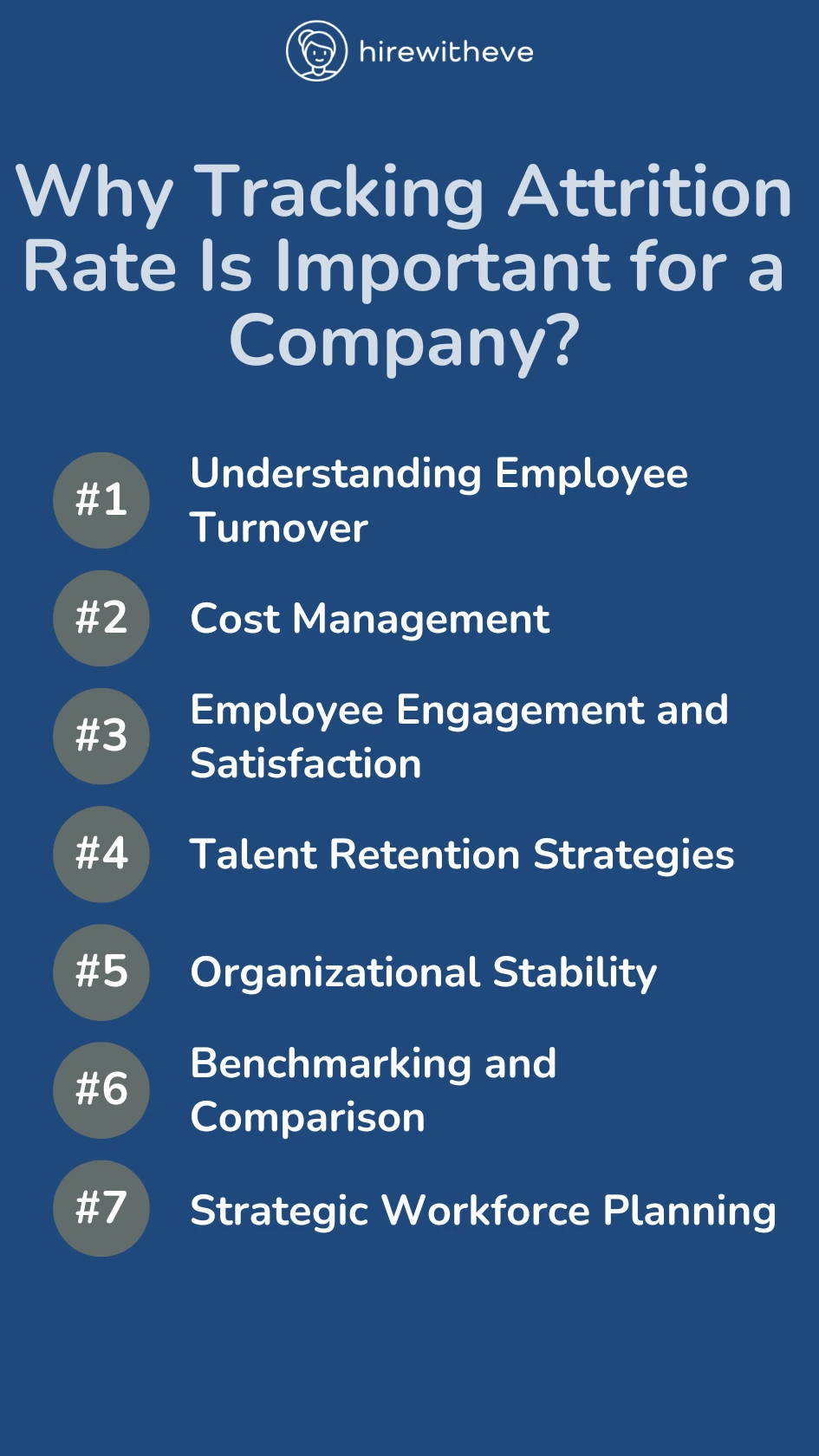What is Attrition Rate, and What Does it Mean for HR?
What is Attrition Rate, and What Does it Mean for HR?

Employee turnover can significantly impact an organization’s performance and culture, making it crucial for HR professionals to grasp its underlying causes.
One key metric to monitor is the attrition rate, which measures the percentage of employees who leave an organization over a specific period. This figure is more than just a number; it offers invaluable insights into employee satisfaction, company culture, and the effectiveness of retention strategies. Analyzing attrition rates can help HR identify underlying issues and implement targeted interventions to foster a more stable and engaged workforce.
In this blog, we’ll find more about what attrition rate means, its significance for HR, and how organizations can effectively manage and reduce it.
Table of contents
What Is an Attrition Rate?
The attrition rate, often referred to as the turnover rate, is a key performance metric used by organizations to measure the percentage of employees who leave the workforce over a specific period, typically expressed annually.
It is calculated by dividing the number of employees who have left the organization during a given timeframe by the average number of employees during that period, then multiplying the result by 100 to express it as a percentage.
A high attrition rate may indicate underlying issues within the organization, such as employee dissatisfaction, poor management practices, or a lack of career development opportunities, while a low attrition rate typically suggests a stable workforce and effective retention strategies.
How to Calculate Attrition Rate?
Calculating the attrition rate is a straightforward process that involves using a specific formula. Here’s how to do it step-by-step, along with a clear example.
The attrition rate can be calculated using the following formula:
Attrition Rate = (Number of Employees Who Left / Average Number of Employees) x 100
Steps to Calculate Attrition Rate
Step 1: Determine the Period: Decide on the time frame for which you want to calculate the attrition rate (e.g., annually, quarterly, or monthly).
Step 2: Count Employees Who Left: Count the total number of employees who left the organization during that period.
Step 3: Calculate Average Number of Employees: Find the average number of employees during the same period. This can be done by adding the number of employees at the beginning of the period to the number of employees at the end of the period and then dividing by two.
Step 4: Apply the Formula: Use the collected data in the attrition rate formula.
Why Tracking Attrition Rate Is Important for a Company?
Tracking attrition rate is crucial for a company for several reasons:

Understanding Employee Turnover
Monitoring attrition rates provides insights into how many employees are leaving the organization and why. This information is vital for identifying patterns or trends in turnover, which can help pinpoint underlying issues within the company culture, management practices, or employee engagement levels.
Cost Management
High attrition rates can be costly for organizations, resulting in increased expenses related to recruitment, onboarding, and training of new employees. By tracking attrition, companies can better understand these costs and take proactive measures to reduce turnover, ultimately saving money and resources.
Employee Engagement and Satisfaction
Tracking attrition rates can serve as an indicator of employee engagement and satisfaction. A rising attrition rate may signal dissatisfaction among employees, prompting the organization to investigate and address the factors contributing to their disengagement.
Talent Retention Strategies
Understanding attrition rates enables HR professionals to develop effective talent retention strategies. By analyzing the reasons behind employee departures, organizations can implement targeted interventions, such as improved training programs, better career development opportunities, or enhanced workplace culture initiatives.
Organizational Stability
High attrition rates can disrupt team dynamics and overall organizational stability. By tracking these rates, companies can work towards maintaining a stable workforce, which is essential for fostering collaboration, consistency, and a sense of community within the organization.
Benchmarking and Comparison
Tracking attrition rates allows companies to benchmark their performance against industry standards and competitors. This comparative analysis can provide valuable insights into how well the organization is managing its workforce and highlight areas for improvement.
Strategic Workforce Planning
Attrition data can inform strategic workforce planning efforts. By understanding turnover trends, organizations can better anticipate future staffing needs, allowing for more effective workforce management and resource allocation.
What Does a “High” Attrition Rate Mean?
A “high” attrition rate generally refers to a significant percentage of employees leaving an organization within a specific period, often raising concerns about workforce stability and employee satisfaction.
Here are some key implications of a high attrition rate:
Employee Dissatisfaction
A high attrition rate may indicate that employees are dissatisfied with various aspects of their jobs, including work conditions, management practices, compensation, or career growth opportunities. This dissatisfaction can lead to a toxic workplace culture and impact overall morale.
Increased Recruitment Costs
Frequent turnover means that the organization incurs higher costs associated with recruiting, hiring, and training new employees. These expenses can strain the company’s budget and affect profitability, especially if the attrition rate is sustained over time.
Loss of Institutional Knowledge
When experienced employees leave, they take valuable knowledge, skills, and insights with them. This loss can hinder productivity and innovation, as new hires may take time to reach the same level of performance as their predecessors.
Impact on Team Dynamics
High attrition can disrupt team cohesion and collaboration. Constantly changing team members may lead to misunderstandings, decreased productivity, and difficulties in achieving organizational goals.
Negative Employer Branding
A high attrition rate can tarnish an organization’s reputation, making it more challenging to attract top talent. Potential candidates may view a high turnover rate as a red flag, questioning the company’s stability and culture.
Need for Strategic Review
A persistently high attrition rate signals the need for organizations to reassess their HR strategies, workplace policies, and employee engagement practices. It may prompt leadership to investigate the root causes of turnover and implement targeted interventions.
Potential for Legal Risks
In some cases, high attrition rates can be indicative of broader issues, such as discrimination or harassment, which may expose the organization to legal risks and compliance challenges.
Is High Attrition Rate Bad for a Company?
Yes, a high attrition rate is generally considered detrimental to a company for several reasons:
Increased Costs
High turnover rates lead to increased recruitment, onboarding, and training expenses. Hiring new employees can be costly, and organizations often face additional expenses related to lost productivity while new hires get acclimated to their roles.
Loss of Institutional Knowledge
When experienced employees leave, they take valuable knowledge and skills with them. This loss can hinder productivity and innovation, as new hires may take time to acquire the same level of expertise.
Disruption of Team Dynamics
Frequent turnover can disrupt team cohesion and collaboration. Teams may struggle with constant personnel changes, which can lead to misunderstandings, decreased morale, and challenges in achieving shared goals.
Negative Impact on Employee Morale
A high attrition rate can create a sense of instability among remaining employees. They may feel overworked or anxious about their job security, leading to decreased morale and engagement.
Challenges in Talent Acquisition
A reputation for high turnover can make it difficult for organizations to attract top talent. Potential candidates may view a high attrition rate as a sign of a toxic work environment or poor management practices.
Strategic Implications
High attrition can signal underlying issues within the organization, such as poor management, lack of career advancement opportunities, or inadequate employee support. This necessitates a strategic evaluation of HR policies and workplace culture.
Impact on Customer Satisfaction
Frequent employee turnover can affect customer service and satisfaction. Inconsistent staffing can lead to gaps in service quality, ultimately impacting the company’s reputation and bottom line.
Conclusion
A high attrition rate can be detrimental to a company, but solutions like HirewithEve can help address this issue. By using targeted hiring assessments, HirewithEve ensures that organizations find candidates who not only have the right skills but also fit well with the company culture.
This approach enhances employee satisfaction and retention, ultimately reducing turnover rates. Additionally, HirewithEve provides valuable insights into successful employee attributes, allowing HR teams to refine their hiring processes for long-term success.
With HirewithEve, companies can combat high attrition rates and create a more stable and engaged workforce.
Target Your Talent
Unlock tailored solutions for your recruitment and hiring needs with Eve Platform's extensive case study library.
Subscribe now to enhance your HR expertise and excel in your role.
Free Resources

Transforming Hiring: 7 Key Recruiting Metrics
Enhancing recruitment processes with data-driven insights for better hiring outcomes.

Reducing Hiring Bias with Hirewitheve.
Utilizing Hirewitheve to combat bias and streamline recruitment processes effectively.

Hiring Detail-Oriented Candidates
HirewithEve enhances hiring by accurately assessing candidate's attention to detail-oriented.
